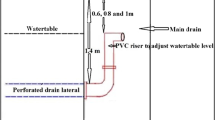Abstract
Saline soils in Pakistan are of three types. First type includes porous saline and saline-sodic soils (4.79 × 106 ha) located in irrigated areas. These soils possess electrical conductivity in the range of 10–15 dS m−1 and can be cultivated with salt-tolerant wheat. A short-duration and short-stature wheat line (SSt) was developed for such areas which is also resistant to lodging that may occur as a consequence of irrigation. The second types of soils (1.5 × 106 ha) have twin problems of salinity and water deficiency and are located in water-deficit areas of southern Punjab and parts of Sindh. A drought-tolerant wheat line (DTL) was developed for these areas which can be grown with only pre-sowing irrigation and can produce grain yield of about 6,000 kg ha−1. The third types of soils (11 × 106 ha) are located in Cholistan, Thar, Thal, and Kharan areas beset with salinity, high rate of evaporation, and strong winds. Water is most critical and limiting factor that prohibits agriculture production under such areas. Wheat variety “DURUGEN” was developed for these soils which combine tolerance for salt, water deficiency, and high temperature. It can be cultivated in desert areas for production of green biomass which can be used (1) as fodder to raise sheep and goats, (2) to provide green cover to barren lands thereby improving both land and the environment, and (3) to help providing livelihood to the poor natives. This chapter provides details of specific wheat genotypes and successful cultivation of these genotypes on saline soils.
Access this chapter
Tax calculation will be finalised at checkout
Purchases are for personal use only
Similar content being viewed by others
References
Anonymous (2000) Agriculture strategies for the first decade of new millennium. Pakistan Agriculture Research Council (PARC), Ministry of Food, Agriculture and Livestock (MINFAL) and Planning and Development Division, Government of Pakistan, Islamabad
FAO (2008) The state of food insecurity in the world. High food prices and food security-threats and opportunities. Food and Agriculture Organization of the United Nations, Room
Farooq S (2004) Salt tolerance in Aegilops species: a success story from research and production to large scale utilization of salt tolerant wheat. In: Taha FK, Ismail S, Jaradat A (eds) Prospects of saline agriculture in Arabian Peninsula. Amherst Scientific Publisher, Amherst, pp 121–134
Farooq S, Azam F (2001) Production of low input and stress tolerant wheat germplasm through the use of biodiversity residing in the wild relatives. Hereditas 135:211–215
Farooq S, Azam F (2007) A new polyploidy wheat for stressed lands and poverty alleviation. Field Crop Res 100:369–373
Farooq S, Niazi MLK, Iqbal N, Shah TM (1989) Salt tolerance potential of wild resources of tribe Triticeae-II. Screening of species of the genus Aegilops. Plant Soil 119:255–260
Farooq S, Iqbal N, Asghar M, Shah TM (1992) Intergeneric hybridization for wheat improvement-VI. Production of salt tolerant wheat germplasm through crossing wheat (Triticum aestivum L.) with Aegilops cylindrica and its significance in practical agriculture. J Genet Breed 46:125–132
Farooq S, Asghar M, Iqbal N, Askari E, Arif M, Shah TM (1995) Production and evaluation of salt tolerant wheat germplasm produced through crossing wheat (Triticum aestivum L.) with Aegilops cylindrica-II. Field evaluation of salt tolerant germplasm. Cer Res Commun 2:275–282
Farooq S, Askari E, Zaidi AA, Shah TM (1998) The wild Aegilops and sustainable agriculture: achievements and anticipations at NIAB. In: El Bassam N, Behl RK, Prochnow B (eds) Sustainable agriculture, for food, energy and industry: strategies towards achievement, vol 2. James and James (Science Publisher), London, pp 662–668
Ghassemi F, Jakman AJ, Nix AH (eds) (1995) Pakistan. In: Salinization of land and water resource: human causes, extent management and case studies. University of New South Wales Press Ltd., Sydney Australia, pp 369–395
Guy C, Porat R, Hurry V (2006) Plant cold and abiotic stress gets hot. Physiol Plant 126:1–4
ICID (1991) Asia year. Country report on Irrigation Drainage Development in Pakistan. Published by International Commission on Irrigation and Drainage, New Delhi, India
Jacobsen T (1982) Salinity and irrigation agriculture in antiquity. Deyala Basin archaeological projects: reports on essential results, 1957–58. Undena Publications, Malibu
Rafique MS, Ahmad I, Shah SAH, Shahzad MA (2000) Effect of different rates and N.P. levels on growth and yield of wheat. IAR., 38, 311–317, McGraw-Hill Book, Cologne, pp 172–177
Wang RC, Li XM, Hu ZM, Zhang JY, Larson SR, Zhang SY, Grieve CM, Shannon MSC (2003a) Development of salinity tolerant wheat recombinant lines from a wheat disomic addition line carrying a Thinopyrum junceum chromosome. Int J Plant Sci 164:25–33
Wang W, Vinocur B, Altman A (2003b) Plant responses to drought, salinity and extreme temperatures: towards genetic engineering for stress tolerance. Planta 218:1–14
Author information
Authors and Affiliations
Corresponding author
Editor information
Editors and Affiliations
Rights and permissions
Copyright information
© 2013 Springer Science+Business Media Dordrecht
About this chapter
Cite this chapter
Farooq, S., Akram, M., Afzal, M., Arshad, R., Azam, F. (2013). Practical, Productive, and Environment-Friendly Utilization of Different Categories of Salt-Affected Soils in Arid and Semiarid Regions of Pakistan. In: Shahid, S., Abdelfattah, M., Taha, F. (eds) Developments in Soil Salinity Assessment and Reclamation. Springer, Dordrecht. https://doi.org/10.1007/978-94-007-5684-7_23
Download citation
DOI: https://doi.org/10.1007/978-94-007-5684-7_23
Published:
Publisher Name: Springer, Dordrecht
Print ISBN: 978-94-007-5683-0
Online ISBN: 978-94-007-5684-7
eBook Packages: Earth and Environmental ScienceEarth and Environmental Science (R0)




